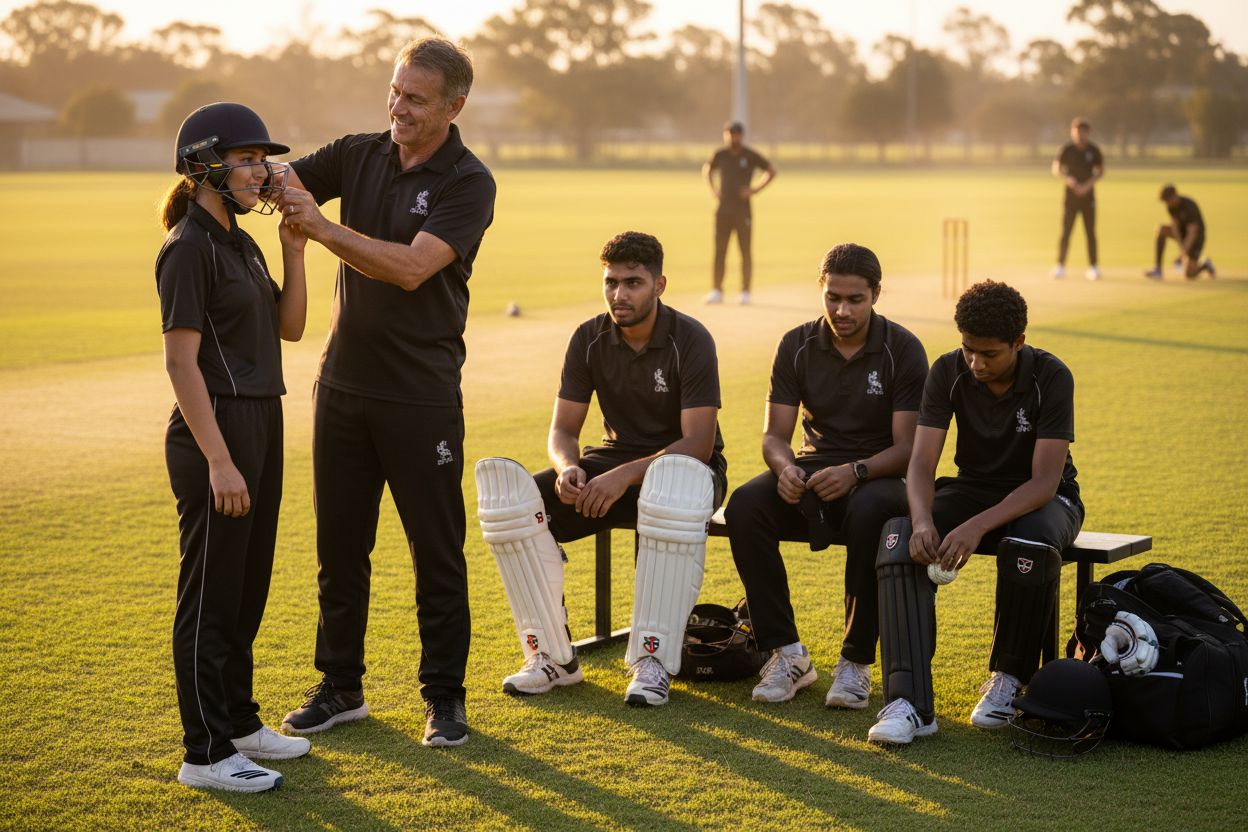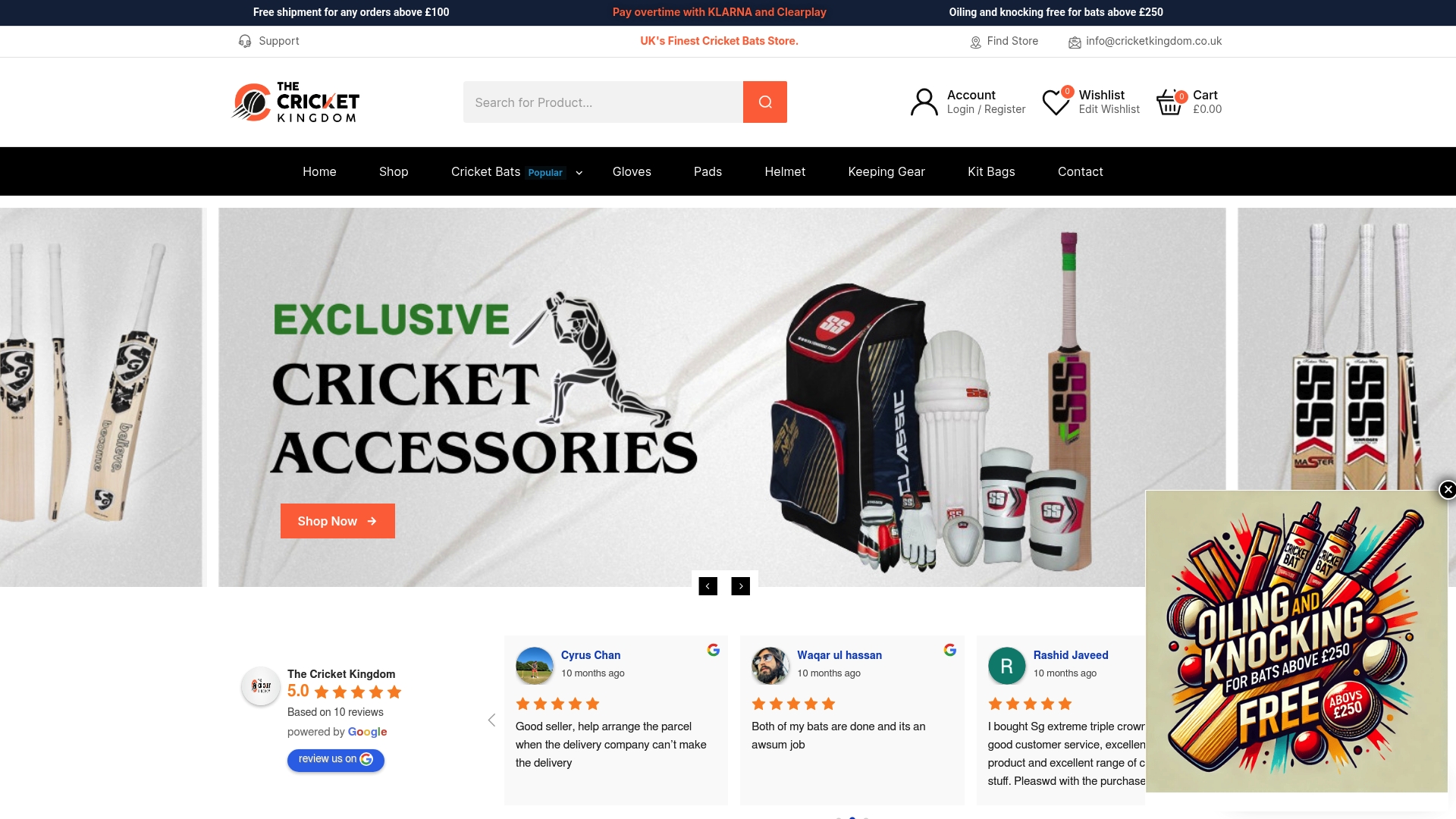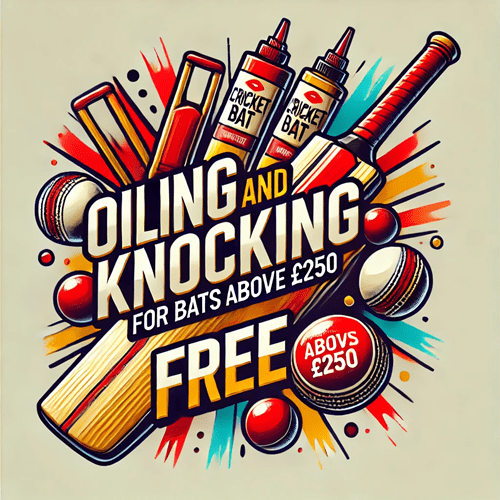7 Key Items in Your Cricket Safety Equipment List

Cricket is packed with epic moments and athletic drama, but those thrilling plays come with real risks. Most people do not realize this, but cricket-related injuries make up nearly 20 percent of all sports injuries. Surprisingly, the best way to protect players is not always more skill or training, but the thoughtful use of the right safety equipment. Let’s dig into why even one missing piece can make all the difference between enjoying the game and sitting out the season.
Table of Contents
- Importance Of Cricket Safety Equipment
- Essential Batting Gear For Safety
- Protective Gear For Fast Bowlers
- The Importance Of Wearing A Helmet
- Choosing The Right Gloves And Pads
- Footwear For Maximum Protection
- Regular Maintenance And Gear Checks
Quick Summary
| Takeaway | Explanation |
|---|---|
| Invest in quality safety gear. | Quality cricket gear is essential to prevent injuries, enhancing player safety and performance. |
| Regularly check your equipment. | Maintenance of safety gear can prevent up to 30% of its protective effectiveness loss over time. |
| Select appropriate batting protection. | Batting helmets, gloves, and pads reduce injury risks significantly, ensuring player confidence. |
| Footwear is key for injury prevention. | Proper cricket shoes with support and cushioning lower limb injury risks and enhance performance. |
| Understand gear specifics for your role. | Different positions require tailored protective gear to meet unique risks and enhance safety effectively. |
1: Importance of Cricket Safety Equipment
Cricket is a thrilling sport that demands skill, strategy, and rigorous physical preparation. While the excitement of the game can be captivating, understanding the critical role of safety equipment is paramount for players at every level. Player protection isn’t just an optional consideration but a fundamental requirement that can prevent serious injuries.
Statistics highlight the importance of proper safety gear. According to Sports Medicine Research, cricket-related injuries account for approximately 15-20% of all sports injuries, with many being preventable through appropriate protective equipment. This underscores the need for a comprehensive cricket safety equipment list that goes beyond basic gear.
Key considerations for cricket safety equipment include:
- Protection against high-velocity ball impacts
- Minimizing risk of head, leg, and hand injuries
- Ensuring player confidence during gameplay
The right safety gear serves multiple crucial functions. It not only shields players from potential physical harm but also provides psychological comfort, allowing athletes to perform without constant fear of injury. Professional and amateur cricketers alike must prioritize safety equipment as an essential investment in their sporting career.
Read our comprehensive guide on cricket gear selection to understand how to choose the most appropriate safety equipment for your specific playing level and requirements. By making informed choices, players can significantly reduce their injury risk and enjoy the game with greater peace of mind.
2: Essential Batting Gear for Safety
Batting in cricket involves significant physical risk, making specialized protective equipment crucial for player safety. The primary focus of batting gear is to shield players from potential high-speed ball impacts that could cause serious injury.
Biomechanical studies demonstrate that cricket balls can travel at speeds exceeding 90 miles per hour, creating substantial potential for trauma. This stark reality underscores the absolute necessity of comprehensive batting protection.
The most critical batting safety equipment includes:
- Batting helmet with robust chin guard
- High-quality protective box/groin guard
- Padded batting gloves
- Leg guards/pads
Professional cricketers understand that quality protective gear is not an expense but an investment in personal safety. Modern batting equipment combines advanced materials like high-density polymers and reinforced padding to provide maximum protection without compromising mobility.
Ergonomic design plays a significant role in modern batting safety gear. Manufacturers now create equipment that offers 360-degree protection while maintaining lightweight characteristics. Players can move freely and respond quickly without feeling encumbered by heavy protective clothing.
Explore our comprehensive cricket equipment checklist to ensure you have all necessary safety items before stepping onto the pitch. Remember, proper equipment selection can mean the difference between a minor impact and a potentially career-ending injury.
3: Protective Gear for Fast Bowlers
Fast bowlers face unique physical challenges that require specialized protective cricket equipment. The high-intensity nature of fast bowling exposes players to significant injury risks, making comprehensive safety gear absolutely critical.
According to Sports Injury Prevention Research, fast bowlers experience substantially higher injury rates compared to other cricket positions, particularly in shoulders, lower back, and lower limbs. This statistical evidence underscores the paramount importance of targeted protective gear.
Key protective equipment for fast bowlers includes:
- Robust bowling shoes with ankle support
- Compression wear to prevent muscle strain
- Protective abdominal guards
- Specialized knee and elbow protective pads
Modern fast bowling protective gear combines advanced material technology with ergonomic design. High-performance fabrics provide compression, muscle stabilization, and impact absorption. These innovations help bowlers maintain peak performance while minimizing injury risks.
Footwear plays a crucial role in a fast bowler’s safety. Specialized bowling shoes with enhanced ankle support and shock absorption can significantly reduce stress on lower body joints during high-intensity bowling actions. Learn more about cricket helmet safety options to understand how comprehensive protective equipment can transform a player’s safety and confidence on the field.
Physical conditioning and proper protective gear work synergistically to protect fast bowlers. By investing in high-quality, technologically advanced safety equipment, players can significantly reduce their injury vulnerability while maintaining optimal athletic performance.
4: The Importance of Wearing a Helmet
Helmet usage represents a critical component of cricket safety equipment, transforming player protection from optional to essential. Cricket helmets are not mere accessories but sophisticated protective devices designed to shield players from potentially life-altering head injuries.
Neurological research reveals that cricket balls traveling at high velocities can cause severe traumatic brain injuries, making helmet protection absolutely imperative. Professional and amateur players alike face substantial risk without proper head protection.
Key helmet protection considerations include:
- Full cranial coverage
- Robust chin guard mechanism
- Lightweight design for comfort
- Impact absorption technology
Modern cricket helmets represent a significant technological advancement in player safety. Contemporary designs incorporate advanced materials like high-density polymers and carbon fiber composites, providing superior protection without compromising mobility or comfort.
Statistically, helmets have dramatically reduced cricket-related head injury incidents. Younger players especially benefit from comprehensive helmet protection, as their developing neurological systems are more vulnerable to potential impact trauma.
Explore our comprehensive guide on cricket helmet types to understand the nuanced protective features available. Selecting the right helmet involves considering factors like fit, material quality, and specific playing position requirements.
Beyond physical protection, helmets provide psychological comfort. Players wearing properly fitted helmets demonstrate increased confidence, allowing them to focus on performance without constant fear of potential head injuries. This mental assurance is as crucial as the physical protection helmets provide.
5: Choosing the Right Gloves and Pads
Gloves and pads represent the critical interface between a cricket player and potential impact injuries. Selecting the right protective gear goes far beyond aesthetic considerations, involving complex biomechanical and safety requirements.
Sports Medicine Research indicates that properly fitted gloves and pads can reduce injury risk by up to 60% during cricket matches. This compelling statistic underscores the importance of meticulous equipment selection.
Critical factors for selecting cricket gloves and pads include:
- Precise fit and anatomical contouring
- High quality impact absorption materials
- Breathability and moisture management
- Flexibility without compromising protection
Modern cricket protective wear combines advanced textile engineering with ergonomic design. Manufacturers now utilize lightweight materials like high-density foam, reinforced leather, and synthetic polymers that provide maximum protection without restricting player movement.
Batting gloves require special attention. They must offer comprehensive hand protection while maintaining tactile sensitivity and grip strength. Professional players understand that glove selection directly impacts batting performance and personal safety.
Discover the perfect batting gloves for your playing style to enhance both your safety and gameplay. Remember that investing in high-quality gloves and pads is not an expense, but a crucial investment in your cricket career and personal well-being.
6: Footwear for Maximum Protection
Cricket footwear represents a critical safety component often overlooked by players, yet it plays a pivotal role in preventing injuries and enhancing performance. Proper cricket shoes are not merely about traction, but provide comprehensive protection for players across different field positions.
Biomechanical Research demonstrates that specialized cricket footwear can reduce lower limb injury risks by up to 45%, highlighting the importance of strategic shoe selection.
Key considerations for cricket footwear safety include:
- Ankle support and stabilization
- Shock absorption technology
- Appropriate spike configuration
- Lightweight yet durable materials
Professional cricketers understand that footwear is more than just equipment – it’s a critical safety interface. Different playing positions require nuanced shoe designs. Bowlers need shoes with enhanced heel support and cushioning, while batsmen require shoes that provide lateral movement flexibility.
Modern cricket shoes incorporate advanced materials like carbon fiber reinforcements and memory foam cushioning. These technological innovations provide superior protection without compromising player mobility. Moisture-wicking fabrics and breathable designs also contribute to overall foot health and comfort during intense gameplay.
The right pair of cricket shoes can prevent numerous potential injuries, from ankle sprains to stress fractures. Players should prioritize fit, support, and position-specific design when selecting their footwear. Explore our comprehensive cricket equipment guide to understand how each piece of gear contributes to your overall safety and performance.
7: Regular Maintenance and Gear Checks
Maintaining cricket safety equipment is as crucial as selecting the right gear. Neglecting regular maintenance can compromise protective capabilities, potentially exposing players to unnecessary risks during gameplay.
Sports Equipment Maintenance Research indicates that improperly maintained protective gear loses up to 30% of its original protective effectiveness within one season of regular use.
Critical maintenance steps for cricket safety equipment include:
- Inspect equipment for visible wear and damage
- Clean and dry gear after each use
- Replace items showing significant deterioration
- Store equipment in cool, dry environments
Professional cricketers treat their safety gear as a critical investment, understanding that regular inspection can prevent potential equipment failure during crucial match moments. Helmets, in particular, require meticulous examination for structural integrity, checking for cracks, padding degradation, and chin strap functionality.
Materials used in modern cricket safety equipment degrade over time, even without visible damage. Factors like UV exposure, humidity, and repeated impact can weaken protective materials. Batters and bowlers should conduct comprehensive gear assessments at least once every three months, or more frequently for intensive players.
Discover our comprehensive cricket equipment maintenance guide to ensure your safety gear remains in optimal condition. Remember, proactive maintenance is your first line of defense against potential sports-related injuries.
Play It Safe With Professional Cricket Gear
Every cricket match brings excitement, but it also comes with real concerns about player safety. As highlighted in “7 Key Items in Your Cricket Safety Equipment List,” the right protective gear can make all the difference between building your game and facing preventable injuries. You deserve to focus on performance instead of worrying about impact injuries, poor equipment fit, or outdated safety gear. Whether you are looking for ergonomically designed batting gloves, advanced helmets, or footwear with superior support, your next step matters for your confidence and your future in cricket.

Don’t settle for less when your safety is on the line. Shop the full range of expert-approved safety equipment now at CricketKingdom.co.uk and build your ideal kit from our celebrated cricket equipment checklist. Take action today because your next game is too important to leave your gear to chance.
Below is a comprehensive table summarizing the key components, main benefits, and essential takeaways from the entire article to help readers quickly review all critical cricket safety equipment recommendations.
| Key Area | Main Focus/Equipment | Benefits/Importance |
|---|---|---|
| Importance of Safety Equipment | Comprehensive protective gear | Reduces risk of serious injuries, ensures player confidence and psychological comfort |
| Essential Batting Gear | Helmet, gloves, leg guards, protective box | Shields against high-speed impacts, combines protection and mobility, essential for both amateurs and professionals |
| Fast Bowler Protection | Bowling shoes, compression wear, abdominal/knee/elbow pads | Tailored to high injury rates in bowling, supports joints and muscles, uses advanced materials for greater effectiveness |
| Helmet Usage | Full-coverage helmet with chin guard | Prevents traumatic brain injuries, enhances confidence and focus, must prioritize fit and advanced impact technology |
| Choosing Gloves and Pads | Well-fitted gloves/pads made from high-quality materials | Reduces injury risk by up to 60%, maintains flexibility, ensures proper grip and comfort |
| Footwear for Protection | Cricket shoes with support, cushioning, spikes | Minimizes lower limb injuries by up to 45%, custom designs for batting and bowling needs, supports foot health |
| Maintenance and Gear Checks | Regular inspections, cleaning, proper storage | Maintains up to 30% more protective effectiveness, prevents equipment failure, prolongs life span of safety gear |
Frequently Asked Questions
What are the essential items in a cricket safety equipment list?
The essential items include a batting helmet, protective box, padded batting gloves, leg guards, robust bowling shoes, abdominal guards, and knee/elbow pads.
How can I ensure that my cricket gear fits properly?
To ensure a proper fit, try on the equipment before purchasing, check for comfort and freedom of movement, and consider sizing charts provided by manufacturers. Remember to test items like helmets and gloves for snugness without being too tight.
Why is it important to maintain cricket safety equipment?
Maintaining cricket safety equipment is crucial because worn or damaged gear can lose its protective effectiveness by up to 30%. Regular checks ensure that equipment remains safe and functional, reducing the risk of injury during play.
What features should I look for in a batting helmet?
Look for helmets that offer full cranial coverage, a robust chin guard mechanism, lightweight materials for comfort, and impact absorption technology to protect against high-speed ball impacts.
Recommended
- Understanding Cricket Gear Buying Guide for Players – The Cricket Kingdom
- 9 Essential Items for Your Cricket Equipment Checklist – The Cricket Kingdom
- Understanding Types of Cricket Helmets for Safety – The Cricket Kingdom
- Essential Cricket Equipment in the UK: Must-Have Gear for Every Cricketer – The Cricket Kingdom


